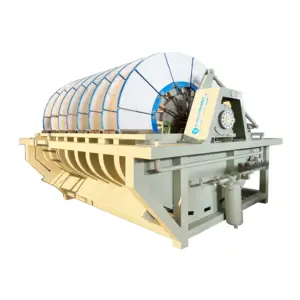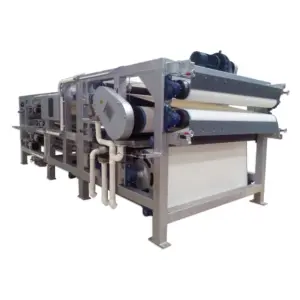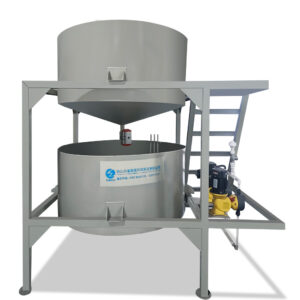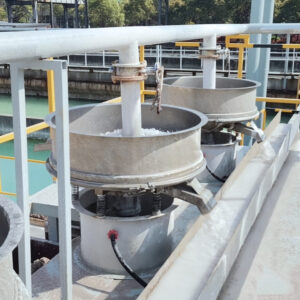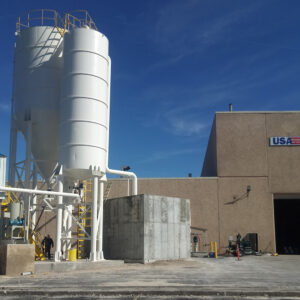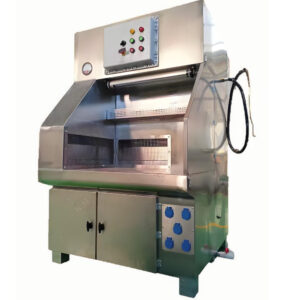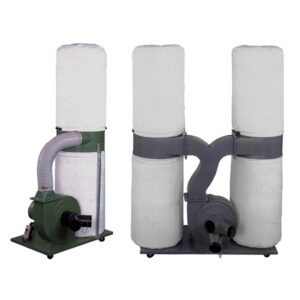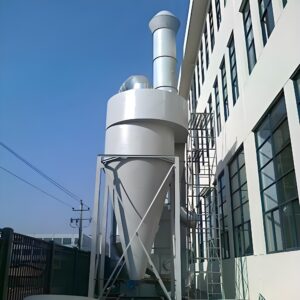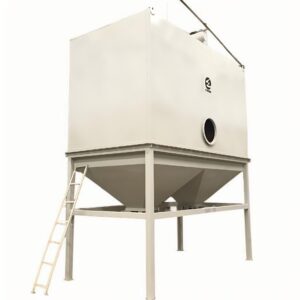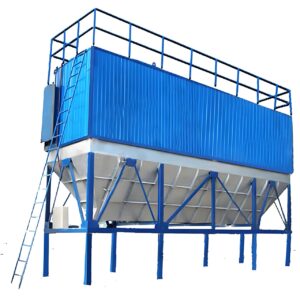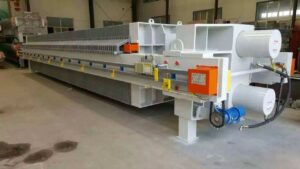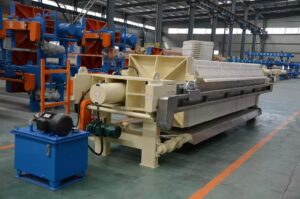تواجه صناعة السيراميك والبلاط لوائح بيئية وتحديات تشغيلية غير مسبوقة، مع فلترة مصنع السيراميك الناشئة كعنصر حاسم للإنتاج المستدام. تولد منشآت التصنيع كميات كبيرة من مياه الصرف الصحي التي تحتوي على جزيئات السيراميك ومركبات التزجيج والمواد الكيميائية المضافة التي تتطلب أنظمة معالجة متطورة. وبدون بنية تحتية مناسبة للترشيح، يتعرض منتجو السيراميك لخطر الانتهاكات التنظيمية وتلف المعدات والعقوبات المالية الكبيرة.
تمتد عواقب عدم كفاية أنظمة الترشيح غير الملائمة إلى ما هو أبعد من مشاكل الامتثال. يمكن لمياه الصرف الخزفية غير المفلترة أن تتسبب في تلف شديد في المعدات النهائية، مع تكاليف استبدال غالبًا ما تتجاوز $500,000 سنويًا للمنشآت متوسطة الحجم. ويؤدي تعطل الإنتاج بسبب الأنظمة المسدودة وتكاليف التنظيف البيئي إلى تفاقم هذه التحديات، مما يخلق كوابيس تشغيلية تؤثر بشكل مباشر على الربحية والقدرة التنافسية في السوق.
يستكشف هذا الدليل الشامل حلول الترشيح المتقدمة لمصانع السيراميك المتقدمة، ويقارن بين التقنيات، ويحلل التكاليف، ويقدم رؤى استراتيجية لمصنعي السيراميك الذين يسعون إلى أنظمة الترشيح المثلى. سوف ندرس التطبيقات الواقعية والمواصفات الفنية والاتجاهات الناشئة التي تحدد معايير الترشيح الحديثة لإنتاج السيراميك.
ما هو ترشيح مصنع السيراميك ولماذا هو مهم؟
يشمل ترشيح مصنع السيراميك المعالجة الشاملة لمياه الصرف الصحي المتولدة أثناء عمليات تصنيع السيراميك والبلاط. بورفو للتكنولوجيا النظيفة متخصص في هذه التطبيقات الصناعية، مدركًا أن إنتاج السيراميك الحديث ينتج عنه مجاري نفايات معقدة تتطلب أساليب معالجة متعددة المراحل.
فهم مجاري نفايات تصنيع السيراميك
يولد إنتاج السيراميك ثلاث فئات أساسية من النفايات التي تتطلب ترشيحًا متخصصًا. تحتوي مياه المعالجة على جسيمات سيراميك عالقة تتراوح بين 50-500 ميكرون، بتركيزات تصل عادةً إلى 2,000-15,000 ملجم/لتر. تُدخل عمليات التزجيج المعادن الثقيلة والسيليكات والمركبات العضوية التي تتطلب معالجة كيميائية قبل الترشيح. تنتج عمليات التبريد والتنظيف مياه الصرف الصحي ذات الحجم الكبير والتركيز المنخفض التي تتطلب فصلًا فعالًا بين المواد الصلبة والسائلة.
يمثل توزيع حجم الجسيمات في مياه الصرف الصحي الخزفية تحديات فريدة من نوعها. فالجسيمات الطينية الدقيقة تخلق معلقات غروانية تقاوم الترسيب التقليدي، في حين أن شظايا السيراميك الأكبر حجمًا يمكن أن تتلف معدات الترشيح دون معالجة مسبقة مناسبة. كما أن تغيرات درجة الحرارة الناتجة عن عمليات الفرن تزيد من تعقيد المعالجة، حيث يؤثر التدوير الحراري على سلوك الجسيمات وكفاءة الترشيح.
متطلبات الامتثال التنظيمي
وقد اشتدت اللوائح البيئية لمصنعي السيراميك بشكل كبير، حيث أصبحت حدود التصريف أكثر صرامة. وتتطلب معايير الاتحاد الأوروبي أن تكون المواد الصلبة العالقة أقل من 35 مجم/لتر، بينما تفرض العديد من الولايات القضائية تركيزات المعادن الثقيلة أقل من 1 مجم/لتر للكروم والرصاص. وبالمثل، تقيد المبادئ التوجيهية لوكالة حماية البيئة في الولايات المتحدة تصريفات صناعة السيراميك، وغالبًا ما تفرض لوائح الولايات متطلبات أكثر صرامة.
تقول الدكتورة مارينا كوالسكي، أخصائية الهندسة البيئية في جامعة ميونيخ التقنية: "يجب أن تتكيف صناعة السيراميك مع المعايير البيئية المتطورة مع الحفاظ على كفاءة الإنتاج". "توفر أنظمة الترشيح الحديثة جسرًا تقنيًا بين الامتثال التنظيمي والجدوى الاقتصادية."
الأثر الاقتصادي لأنظمة الترشيح
يوفر الاستثمار في الترشيح المناسب للمصانع الخزفية عوائد قابلة للقياس من خلال تقليل تكاليف التخلص من النفايات، وفرص إعادة تدوير المياه، وضمان الامتثال التنظيمي. تشير بيانات الصناعة إلى أن أنظمة الترشيح الشاملة تقلل عادةً من التكاليف الإجمالية لإدارة مياه الصرف الصحي بنسبة 35-451 تيرابايت في غضون ثلاث سنوات من التنفيذ.
| عامل التكلفة | بدون ترشيح | مع الترشيح المتقدم | الوفورات السنوية |
|---|---|---|---|
| التخلص من النفايات | $125,000 | $45,000 | $80,000 |
| شراء المياه | $85,000 | $52,000 | $33,000 |
| الغرامات التنظيمية | $25,000 | $0 | $25,000 |
| تلف المعدات | $75,000 | $15,000 | $60,000 |
كيف تعمل أنظمة الترشيح في مصنع البلاط؟
فلترة مصنع البلاط توظف أنظمة المعالجة متعددة المراحل المصممة لمعالجة الخصائص الفريدة لمياه الصرف الصحي لتصنيع السيراميك. تدمج هذه الأنظمة طرق المعالجة الفيزيائية والكيميائية والبيولوجية لتحقيق جودة تصريف متسقة مع تعظيم استعادة الموارد.
مراحل العلاج الأولية
وتركز مرحلة المعالجة الأولية على إزالة الحطام الكبير وتقليل المواد الصلبة العالقة من خلال الغربلة والترسيب. تلتقط الغرابيل الاهتزازية ذات الفتحات من 1-3 مم شظايا السيراميك وقطع الصقيل، مما يمنع تلف المعدات في المراحل النهائية. ثم تقوم فواصل الجاذبية أو أجهزة التصفية بعد ذلك بإزالة المواد الصلبة العالقة السائبة، وعادةً ما تحقق كفاءة إزالة 60-75% للجسيمات الأكبر من 100 ميكرون.
يعمل التخثر الكيميائي على تعزيز فعالية المعالجة الأولية عن طريق تحييد شحنات الجسيمات وتعزيز التلبد. تخلق معدلات جرعات كبريتات الألومنيوم أو كلوريد الحديديك بمعدلات جرعات تتراوح بين 100-300 ملجم/لتر الظروف المثلى لتجميع جسيمات السيراميك. يعمل ضبط الأس الهيدروجيني إلى 6.5-7.5 على تحسين أداء مادة التخثر مع إعداد مياه الصرف لمراحل المعالجة الثانوية.
تقنيات الترشيح المتقدمة
تستخدم المعالجة الثانوية تكنولوجيات ترشيح متطورة مصممة خصيصًا لمتطلبات صناعة السيراميك. تجمع المفاعلات الحيوية الغشائية بين المعالجة البيولوجية والترشيح الفائق، مما يحقق إزالة المواد الصلبة العالقة التي تتجاوز 99% مع معالجة الملوثات العضوية من عمليات التزجيج. وتتعامل هذه الأنظمة مع معدلات تحميل هيدروليكية تصل إلى 25 لتر/م²/ساعة مع الحفاظ على جودة نفاذية ثابتة.
يوفر الترشيح الغشائي الخزفي متانة استثنائية لبيئات تصنيع السيراميك القاسية. تقاوم هذه الأنظمة الهجوم الكيميائي من محاليل التزجيج الحمضية وتحافظ على الأداء في ظروف درجات الحرارة العالية. تقلل تكوينات الترشيح عبر التدفق المتقاطع من تلوث الأغشية مع تحقيق معدلات تدفق تتراوح بين 150-250 لتر/م²/ساعة لتطبيقات مياه الصرف الصحي الخزفية.
استعادة المياه وإعادة استخدامها
تشتمل أنظمة الترشيح الحديثة لتصنيع البلاط على تقنيات استعادة المياه التي تستعيد 85-95% من مياه المعالجة لإعادة استخدامها. تعمل أنظمة التناضح العكسي على صقل المياه المرشحة إلى معايير الجودة المناسبة لعمليات خلط السيراميك والتبريد. تزيل أنظمة التبادل الأيوني المعادن النزرة وتضبط كيمياء المياه من أجل ظروف إنتاج السيراميك المثلى.
معدات الترشيح المتقدمة تمكين برامج إعادة تدوير المياه الشاملة التي تقلل بشكل كبير من استهلاك المياه العذبة مع الحفاظ على معايير جودة المنتج.
ما هي أفضل فلاتر صناعة السيراميك للتطبيقات المختلفة؟
تختلف مرشحات صناعة السيراميك بشكل كبير بناءً على عمليات التصنيع المحددة وأحجام الإنتاج ومتطلبات التفريغ. إن فهم نهج الترشيح الأمثل لكل تطبيق يضمن أقصى قدر من الكفاءة والفعالية من حيث التكلفة.
مرشحات الضغط للعمليات ذات الحجم الكبير
تتفوق أنظمة الترشيح بالضغط في منشآت تصنيع السيراميك ذات الحجم الكبير التي تعالج أكثر من 10,000 جالون يوميًا. وتحقق هذه الأنظمة محتويات رطوبة الكعكة أقل من 25% أثناء التعامل مع معدلات تحميل المواد الصلبة التي تتجاوز 200 كجم/م²/ساعة. تحافظ أنظمة التنظيف الآلي للقماش على معدلات ترشيح متسقة مع تقليل متطلبات تدخل المشغل.
تكوينات مكابس الترشيح مع ألواح البولي بروبلين تقاوم الهجوم الكيميائي من المواد الكيميائية لمعالجة السيراميك. تستوعب أحجام الحجرة من 10-50 لترًا أحجام دفعات مختلفة مع الحفاظ على المرونة لتركيبات السيراميك المختلفة. تتراوح أوقات الدورات عادةً من 2-6 ساعات اعتمادًا على تركيز المواد الصلبة وجفاف الكعكة المطلوب.
الترشيح بالتفريغ للعمليات المستمرة
يوفر الترشيح المستمر بالتفريغ المستمر حلولاً مثالية لمصانع السيراميك التي تتطلب تشغيلًا متواصلًا. تحقق المرشحات الأسطوانية الدوارة المزودة بوسائط الترشيح المقاومة للسيراميك معدلات ترشيح تتراوح بين 50-150 كجم/م²/ساعة مع إنتاج كعكات الترشيح المناسبة للتخلص منها أو استعادة المواد الخام الخزفية.
توفر أنظمة الترشيح بالحزام أداءً فائقًا لجسيمات السيراميك الدقيقة، مما يحقق كفاءة التقاط المواد الصلبة 95% مع تكييف البوليمر. وتتعامل هذه الأنظمة مع معدلات تدفق تصل إلى 500 متر مكعب/ساعة مع الحفاظ على أداء متسق عبر ظروف المؤثرات المختلفة.
أنظمة الأغشية الخزفية
يمثل الترشيح بالغشاء الخزفي التقنية المتميزة لتطبيقات صناعة السيراميك التي تتطلب جودة ترشيح استثنائية. وتحقق هذه الأنظمة مستويات تعكر أقل من 0.1 NTU مع إزالة 99.9% من المواد الصلبة العالقة. تقلل ضغوط التشغيل من 1-3 بار من استهلاك الطاقة مع الحفاظ على معدلات تدفق عالية.
تتيح المقاومة الكيميائية للأغشية الخزفية بروتوكولات التنظيف القوية باستخدام المحاليل الكاوية والحمضية. تضمن هذه القدرة أداءً ثابتًا في بيئات تصنيع السيراميك الصعبة حيث تفشل أغشية البوليمر التقليدية بسرعة.
| نوع المرشح | نطاق السعة | إزالة المواد الصلبة | مستوى الصيانة | التكلفة الرأسمالية |
|---|---|---|---|---|
| مرشح الضغط | 100-1000 متر مكعب/اليوم | 98-99% | معتدل | متوسط |
| مرشح تفريغ الهواء | 50-500 متر مكعب/اليوم | 95-97% | منخفضة | منخفضة |
| غشاء السيراميك | 10-500 متر مكعب/اليوم | 99.9% | عالية | عالية |
كيف يمكن تحسين أداء ترشيح تصنيع البلاط؟
تحسين ترشيح تصنيع البلاط تتطلب المراقبة المنهجية والصيانة الوقائية وتقييم الأداء المستمر. وتقلل استراتيجيات التحسين الفعالة من تكاليف التشغيل مع ضمان جودة التصريف المتسقة والامتثال التنظيمي.
أنظمة مراقبة الأداء
تتعقب أنظمة المراقبة في الوقت الحقيقي معلمات الترشيح الحرجة بما في ذلك التعكر، والأس الهيدروجيني، ومعدلات التدفق، وفوارق الضغط. يتيح تسجيل البيانات الآلي تحليل الاتجاهات وجدولة الصيانة التنبؤية. تشير قياسات العكارة التي تقل عن 5 NTU إلى أداء الترشيح الأمثل، بينما تشير زيادة فروق الضغط إلى تلوث الغشاء أو تدهور وسائط الترشيح.
دقة مقياس التدفق في حدود ±2% تضمن دقة الجرعات الكيميائية وحسابات التحميل الهيدروليكي. مراقبة الأس الهيدروجيني مع الضبط التلقائي تحافظ على ظروف التخثر المثلى مع حماية المعدات النهائية من ظروف التآكل.
استراتيجيات التحسين الكيميائي
يقلل تحسين جرعات المخثر من التكاليف الكيميائية مع الحفاظ على فعالية المعالجة. يحدد اختبار الجرة معدلات الجرعات المثلى لخصائص مياه الصرف الصحي الخزفية المتفاوتة، والتي تتراوح عادةً بين 75-250 مجم/لتر اعتمادًا على تركيزات المواد الصلبة العالقة. وتعزز إضافة البولي إلكتروليت عند 1-5 ملجم/لتر من تكوين الكتل وتقلل من أوقات الترسيب.
يعمل تحسين الأس الهيدروجيني على تحقيق التوازن بين كفاءة التخثر ومتطلبات المعالجة النهائية. تعمل الظروف الحمضية (الأس الهيدروجيني 5.5-6.0) على تحسين التخثر القائم على الألومنيوم، في حين أن مستويات الأس الهيدروجيني الأعلى (7.0-7.5) تفيد أنظمة كلوريد الحديديك. تحافظ أنظمة التحكم الآلي في الأس الهيدروجيني على نقاط الضبط في حدود ± 0.2 وحدة لتحقيق أداء متسق.
أفضل ممارسات الصيانة
تعمل برامج الصيانة المجدولة على منع الأعطال الكارثية مع تحسين طول عمر النظام. تحدد عمليات الفحص البصري اليومية المشاكل النامية قبل أن تؤثر على الأداء. يتحقق اختبار الضغط الأسبوعي من سلامة النظام بينما يحافظ التنظيف الكيميائي الشهري على أداء الغشاء.
ويوضح جيمس موريسون، مهندس العمليات الذي يتمتع بخبرة 15 عامًا في صناعة السيراميك قائلاً: "تقلل الصيانة الاستباقية من وقت تعطل نظام الترشيح الخزفي بنسبة 60-701 تيرابايت 3 تيرابايت مقارنةً بالنهج التفاعلي". "المفتاح هو وضع بروتوكولات متسقة وتدريب المشغلين على التعرف على علامات الإنذار المبكر."
تعمل جدولة استبدال وسائط المرشح على أساس معايير الأداء بدلاً من الفترات الزمنية على تحسين التكاليف مع ضمان الجودة. تشير زيادات فرق الضغط التي تزيد عن 150% من القيم الأساسية عادةً إلى الحاجة إلى الصيانة أو استبدال الوسائط.
ما هي التحديات الموجودة في ترشيح إنتاج السيراميك للإنتاج الخزفي؟
فلترة إنتاج السيراميك تواجه العديد من التحديات التقنية والتشغيلية التي تتطلب حلولاً مبتكرة وتصميماً دقيقاً للنظام. ويتيح فهم هذه التحديات إمكانية وضع استراتيجيات استباقية للتخفيف من حدة هذه التحديات وتوقعات أداء واقعية.
تحديات توزيع حجم الجسيمات
يولد تصنيع السيراميك جسيمات عبر نطاق حجم واسع للغاية، بدءًا من جسيمات الطين دون الميكرون إلى شظايا السيراميك بحجم المليمتر. ويعقد هذا التوزيع تصميم نظام الترشيح، حيث لا توجد تقنية واحدة تتعامل بفعالية مع الطيف بأكمله. تخلق الجسيمات الدقيقة مشاكل في تلوث الأغشية، بينما تتسبب الشظايا الكبيرة في تلف مكونات المعدات الحساسة.
يمثل الاستقرار الغرواني للجسيمات الخزفية الدقيقة تحديات إضافية. وتمنع الشحنات الكهروستاتيكية الترسيب الطبيعي، مما يتطلب تكييفًا كيميائيًا للإزالة الفعالة. وتتطلب خصائص الجسيمات المتغيرة من تركيبات السيراميك المختلفة أساليب معالجة مرنة.
مشكلات التوافق الكيميائي
تخلق المواد الكيميائية لمعالجة السيراميك بيئات عدوانية تتحدى مواد معدات الترشيح. ويتسبب حمض الهيدروفلوريك المستخدم في عمليات الحفر في تآكل مكونات الفولاذ المقاوم للصدأ، مما يتطلب سبائك متخصصة أو بدائل بوليمرية. تتسبب محاليل التزجيج القلوية في تقصف وسائط الترشيح التقليدية.
تؤدي الاختلافات في درجات الحرارة من عمليات القمائن إلى تفاقم تحديات التوافق الكيميائي. يؤدي التدوير الحراري إلى إجهاد مكونات المعدات مع التأثير على معدلات التفاعل الكيميائي وأداء الترشيح.
القيود الاقتصادية
وغالبًا ما تتجاوز التكاليف الرأسمالية لأنظمة الترشيح الخزفية الشاملة $2-5 مليون تيرابايت إلى 5 ملايين تيرابايت للمنشآت الكبيرة، مما يخلق عوائق مالية أمام المصنعين الأصغر حجمًا. تضيف تكاليف التشغيل بما في ذلك الطاقة والمواد الكيميائية والصيانة $0.15 إلى 0.35 لكل متر مكعب من مياه الصرف الصحي المعالجة.
في حين أن هذه التكاليف تمثل تحديات, حلول الترشيح الصناعي توفير قيمة طويلة الأجل من خلال تقليل المخاطر التنظيمية وتحسين الكفاءة التشغيلية.
كيف تؤثر معالجة مياه الصرف الصحي لمصانع البلاط على الاستدامة؟
معالجة مياه الصرف الصحي في مصنع البلاط تلعب دورًا حاسمًا في التصنيع المستدام للسيراميك، مما يتيح استعادة الموارد وحماية البيئة ومبادئ الاقتصاد الدائري. تعمل أنظمة المعالجة الحديثة على تحويل مياه الصرف الصحي من مشكلة التخلص منها إلى فرصة لاستعادة الموارد.
فرص استرداد الموارد
تتيح أنظمة الترشيح المتقدمة استعادة المواد الخزفية القيمة لإعادة استخدامها في عمليات الإنتاج. توفر كعكة الترشيح التي تحتوي على 60-80% من المواد الصلبة الخزفية التي تحتوي على 60-80% المواد الخام لمنتجات السيراميك منخفضة الدرجة، مما يقلل من تكاليف المواد بمقدار 15-25%. تستعيد أنظمة استعادة المياه 85-95% من مياه المعالجة، مما يقلل بشكل كبير من استهلاك المياه العذبة.
يقلل استرداد الطاقة الحرارية من التبادل الحراري لمياه الصرف الصحي من استهلاك الطاقة في المنشأة بنسبة 8-12%. ويفيد هذا التكامل الحراري بشكل خاص المنشآت ذات العمليات المستمرة التي تتطلب تسخين العمليات.
الحد من الأثر البيئي
المعالجة الشاملة لمياه الصرف الصحي تقضي على تصريف جزيئات السيراميك التي تساهم في تلف النظام البيئي المائي. إن تقليل المواد الصلبة العالقة من أكثر من 10,000 ملغم/لتر إلى أقل من 35 ملغم/لتر يمنع الترسبات في المصب وتعطيل الموائل. إزالة المعادن الثقيلة تحمي موارد المياه الجوفية من التلوث.
يؤدي خفض البصمة الكربونية من خلال إعادة تدوير المياه إلى التخلص من طاقة النقل والمعالجة المرتبطة بإمدادات المياه العذبة والتخلص من مياه الصرف الصحي. وعادة ما تحقق المرافق التي تطبق المعالجة الشاملة تخفيضاً يتراوح بين 25 و351 تيرابايت في انبعاثات الكربون المرتبطة بالمياه.
مواءمة الاتجاهات التنظيمية
تفضل اللوائح البيئية المتطورة بشكل متزايد المرافق ذات قدرات المعالجة المتقدمة. إن متطلبات التصريف الصفري للسوائل في المناطق التي تعاني من الإجهاد المائي تجعل أنظمة الترشيح الشاملة ضرورية لاستمرار العمليات. وتحسن اتجاهات فرض الضرائب على الكربون وتسعير المياه الحالة الاقتصادية لأنظمة المعالجة المتقدمة.
تقول الدكتورة إيلينا فاسكيز، مديرة الاستدامة في الرابطة الأوروبية لصناعة السيراميك: "تتطلب الاستدامة في صناعة السيراميك النظر إلى معالجة مياه الصرف الصحي على أنها إدارة للموارد بدلاً من التخلص من النفايات". "تتيح أنظمة الترشيح المتقدمة هذا التحول مع ضمان الامتثال التنظيمي في الوقت نفسه."
| مقياس الاستدامة | قبل العلاج | بعد العلاج المتقدم | التحسينات |
|---|---|---|---|
| استهلاك المياه | 15 متر مكعب/طن من السيراميك | 4 متر مكعب/طن من السيراميك | تخفيض 73% |
| توليد النفايات | 2.5 طن/يوميًا | 0.3 طن/اليوم | تخفيض 88% |
| استهلاك الطاقة | 125 كيلوواط/ساعة/م³ | 85 كيلوواط/ساعة/م³ | تخفيض 32% |
الخاتمة
يمثل ترشيح مصنع السيراميك استثمارًا مهمًا في التصنيع المستدام الذي يوفر الامتثال البيئي والكفاءة التشغيلية والفوائد الاقتصادية. يمكّن دمج تقنيات الترشيح المتقدمة مصنعي السيراميك من تلبية متطلبات التصريف الصارمة بشكل متزايد مع خلق فرص لاستعادة الموارد وخفض التكاليف.
عصري فلترة مصنع السيراميك تحقق الأنظمة إزالة المواد الصلبة العالقة التي تتجاوز 99%، وتقليل المعادن الثقيلة إلى أقل من الحدود التنظيمية، ومعدلات استرداد المياه تتراوح بين 85-95%. تدعم مستويات الأداء هذه أهداف التصريف الصفري للسوائل مع الحفاظ على مرونة الإنتاج ومعايير الجودة. وتبرر الفوائد الاقتصادية، بما في ذلك توفير $80,000-200,000 دولار أمريكي سنويًا للمنشآت النموذجية، الاستثمار الرأسمالي في غضون 2-4 سنوات.
واستشرافًا للمستقبل، سيركز الترشيح في صناعة السيراميك بشكل متزايد على مبادئ الاقتصاد الدائري، حيث ستصبح تكنولوجيا المفاعلات الحيوية الغشائية وعمليات الأكسدة المتقدمة مكونات قياسية. ستعمل أنظمة المراقبة الذكية والصيانة التنبؤية على تحسين الأداء مع تقليل التعقيد التشغيلي. ستؤدي المخاوف المتعلقة بالتكيف مع تغير المناخ وندرة المياه إلى زيادة اعتماد أنظمة شاملة لمعالجة المياه وإعادة تدويرها.
بالنسبة لمصنعي السيراميك الذين يقيّمون استثمارات أنظمة الترشيح، تشمل الاعتبارات الرئيسية حجم الإنتاج ومتطلبات التصريف وتكاليف المياه والاتجاهات التنظيمية. ويضمن التعاون مع متخصصي الترشيح ذوي الخبرة تصميم النظام الأمثل والأداء طويل الأجل. الانتقال إلى أنظمة الترشيح المتقدمة معدات الترشيح الخزفية لا يمثل فقط الامتثال التنظيمي، بل يمثل استثمارًا استراتيجيًا في تصنيع السيراميك المستدام والمربح.
ما هي تحديات الترشيح المحددة التي تواجهها عملية تصنيع السيراميك لديك، وكيف يمكن لأنظمة المعالجة المتقدمة أن تعالج هذه المخاوف مع دعم أهداف الاستدامة لديك؟
الأسئلة المتداولة
Q: ما هو ترشيح مصنع السيراميك في سياق حلول صناعة البلاط؟
ج: يشير ترشيح المصنع الخزفي في حلول صناعة البلاط إلى استخدام الأغشية الخزفية وغيرها من أنظمة الترشيح القائمة على السيراميك لمعالجة مياه الصرف الصحي وإزالة الشوائب الناتجة أثناء تصنيع البلاط. تستخدم أنظمة الترشيح هذه أغشية السيراميك ذات المسام الصغيرة لتصفية المواد الصلبة العالقة والملوثات المستحلبة، وجزيئات الغبار، مما يضمن مياه أنظف لإعادة التدوير وتقليل التأثير البيئي. تدعم هذه العملية التصنيع المستدام للبلاط من خلال تقليل هدر المياه والتحكم في انبعاثات التلوث بكفاءة.
Q: كيف يفيد الترشيح بالغشاء الخزفي مصانع بلاط السيراميك؟
ج: يفيد الترشيح بالغشاء الخزفي مصانع بلاط السيراميك من خلال:
- إزالة الجسيمات الدقيقة والملوثات من مياه الصرف الصحي دون استخدام المواد الكيميائية الثقيلة
- السماح باستعادة وإعادة استخدام المياه والمواد الخام القيمة مثل الطين الزجاجي وطين الطين
- خفض التكاليف التشغيلية المتعلقة باستهلاك المياه والمعالجات الكيميائية
- تعزيز الامتثال للوائح البيئية لتصريف مياه الصرف الصحي
- توفير ترشيح قوي مقاوم لدرجات الحرارة المرتفعة وتغيرات الأس الهيدروجيني والتلوث، مما يضمن عمرًا طويلًا للنظام وموثوقية طويلة
وبشكل عام، يعمل على تحسين الأداء الاقتصادي والبيئي في إنتاج البلاط.
Q: ما هي أنواع الملوثات التي تتم إزالتها بواسطة أنظمة الترشيح في مصنع السيراميك في صناعة البلاط؟
ج: تزيل أنظمة الترشيح المصنوعة من السيراميك في المصنع بفعالية:
- المواد الصلبة العالقة والغبار الناعم من عمليات إنتاج البلاط
- الملوثات المستحلبة في مجاري مياه الصرف الصحي
- الجسيمات الزجاجية المتبقية وجسيمات الطين لإعادة استخدام المواد لإعادة استخدامها
- البقايا الكيميائية التي قد تلوث تصريف المياه
وتستخدم هذه الأنظمة أغشية خزفية فائقة الدقة بأحجام مسام أقل من 0.05 ميكرون بشكل عام، مما يؤدي إلى تصفية الشوائب المجهرية بكفاءة مع السماح بمرور المياه النظيفة.
Q: ما الذي يجعل الترشيح بالأغشية الخزفية متفوقًا على طرق الترشيح التقليدية في تصنيع البلاط؟
ج: الترشيح بالغشاء الخزفي متفوق لأنه:
- يوفر ثباتًا كيميائيًا وحراريًا أعلى، ويتحمل ظروف المعالجة القاسية
- يتطلب إضافات كيميائية أقل، مما يجعله أكثر صداقة للبيئة
- يوفر مقاومة أكبر للتلوث، مما يقلل من وقت التعطل والصيانة
- يحقق ترشيحاً أدق للحصول على مياه ومواد أفضل
- يدعم التشغيل المستمر والآلي بأداء ثابت ومتسق
تؤدي هذه المزايا إلى تحسين الاستدامة وتوفير التكاليف في عمليات مصنع البلاط.
Q: هل يمكن لأنظمة الترشيح في مصنع السيراميك أن تساعد في إعادة تدوير التزجيج والانزلاق في إنتاج البلاط؟
ج: نعم، تم تصميم أنظمة الترشيح في مصنع السيراميك خصيصًا لاستعادة المياه والمواد الصلبة مثل الطلاء الزجاجي واللبن الزجاجي ومواد الانزلاق. فهي تحافظ على توزيع حجم الجسيمات وكثافة هذه المواد بعد الترشيح، مما يسمح بإعادة استخدامها مباشرة في عملية الإنتاج. وهذا يقلل من نفايات المواد الخام ويقلل التكاليف من خلال إعادة تدوير المدخلات الرئيسية دون المساس بجودة البلاط.
Q: ما هي العوامل التي يجب على مصنعي البلاط أخذها في الاعتبار عند اختيار حلول الترشيح الخزفية؟
ج: يجب على مصنعي البلاط مراعاة ما يلي:
- حجم مسام الترشيح وملاءمة تقنية الأغشية لتركيبة مياه الصرف الصحي الخاصة بها
- مواءمة سعة النظام مع أحجام الإنتاج
- مقاومة درجات الحرارة، ودرجة الحموضة، والتعرض للمواد الكيميائية المعتادة في صناعة البلاط
- سهولة الصيانة وطرق التنظيف لتقليل وقت التعطل إلى أدنى حد ممكن
- قدرات التكامل مع البنية التحتية الحالية لمعالجة المياه وإعادة تدويرها
يضمن اختيار الترشيح الخزفي المناسب الأداء الأمثل والامتثال التنظيمي والفعالية من حيث التكلفة في حلول صناعة البلاط.
الموارد الخارجية
- بلاط السيراميك - Xtract Filtration Systems Ltd - تشرح دراسة الحالة هذه كيف قامت إحدى الشركات المصنعة لبلاط السيراميك بتطبيق نظام استصلاح التزجيج والانزلاق لاستعادة الموارد وتحسين عمليات إنتاج البلاط.
- مرشحات Mantec الخزفية لتطبيقات الترشيح الشاقة - توفر شركة Mantec Filtration منتجات السيراميك المسامية التقنية مثل الأنابيب والبلاط للترشيح الصناعي، بما في ذلك التطبيقات ذات الصلة بقطاع تصنيع البلاط.
- الترشيح بالأغشية الخزفية لمياه الصرف الصناعي - تقدم Kemco Systems تفاصيل حلول الترشيح بالأغشية الخزفية لإعادة تدوير مياه الصرف الصناعي، مع تسليط الضوء على مزاياها لمصانع التصنيع.
- أغشية السيراميك - TAMI Industries - تصف شركة TAMI Industries مرشحات الأغشية الخزفية الخاصة بها لتطبيقات الفصل الصناعي وتنقية المياه في العديد من الصناعات، بما في ذلك السيراميك.
- تقنية الترشيح بالغشاء الخزفي في معالجة مياه الصرف الصناعي - يناقش هذا المورد التطورات والاستخدام الصناعي لأنظمة الترشيح الغشائي الخزفي لمعالجة مياه الصرف الصحي القوية.
- حلول الترشيح لصناعة السيراميك - تحدد شركة Lenntech طرق وأنظمة الترشيح المصممة لتصنيع السيراميك والبلاط، مع التركيز على معالجة المياه وإدارة النفايات.
